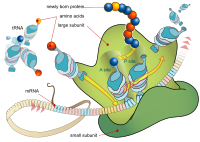
Photo from wikipedia
Protein translation leading to polypeptide synthesis involves three distinct events, namely, initiation, elongation, and termination. Translation initiation is a multi-step process that is carried out by ribosomes on the mRNA… Click to show full abstract
Protein translation leading to polypeptide synthesis involves three distinct events, namely, initiation, elongation, and termination. Translation initiation is a multi-step process that is carried out by ribosomes on the mRNA with the assistance of a large number of proteins called translation initiation factors. Trypanosomatids are kinetoplastidas (flagellated protozoans), some of which cause acute disease syndromes in humans. Vector-borne transmission of protozoan parasites like Leishmania and Trypanosoma causes diseases that affect a large section of the world population and lead to significant morbidity and mortality. The mechanisms of translation initiation in higher eukaryotes are relatively well understood. However, structural and functional conservation of initiation factors in trypanosomatids are only beginning to be understood. Studies carried out so far suggests that at least in Leishmania and Trypanosoma eIF4E function may not be restricted to canonical translation initiation and some of the homologues may have alternate/non-canonical functions. Nonetheless, all of them bind the cap analogs, albeit with different efficiencies, indicating that this property may play an important role in the functionality of eIF4Es. Here, I give a brief background of trypanosomatid eIF4Es and revisit the cap-binding signatures of eIF4E orthologues in trypanosomatids, whose genome sequences are available, in detail, in comparison to human eIF4E1 and Trypanosoma cruzi eIF4E5, with an expanded list of members of this group in light of newer findings. The group 1 and 2 eIF4Es may use either a variation of heIF4E1 or T. cruzi eIF4E5 cap-4-binding signatures, while eIF4E5 and eIF4E6 use distinct amino acid contacts.
Journal Title: Molecular and Cellular Biochemistry
Year Published: 2020
Link to full text (if available)
Share on Social Media: Sign Up to like & get
recommendations!